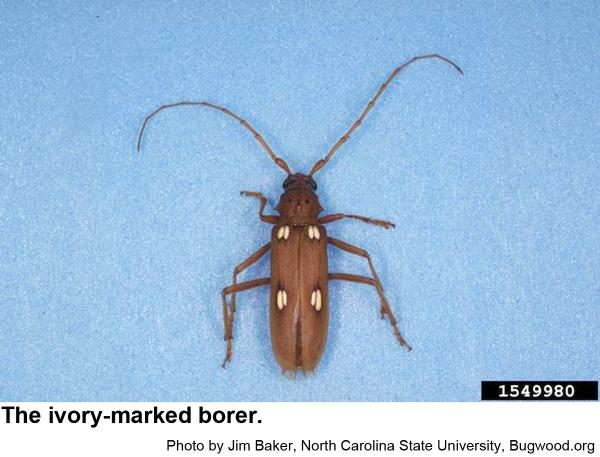Description and Biology
The ivory-marked wood borer, Eburia quadrigeminata, is a longhorned beetle about 1/2 inch long. These beetles are brown to golden brown and have four pairs of ivory spots on their wings. Each pair is surrounded by a darker brown halo. The thorax has a small spine on each side. These beetles feed on leaves and twigs. Females lay eggs in the cracks of dead trees. Tiny grubs hatch and bore into the heartwood where they complete their development usually within two years. However, if an infested tree is sawed and milled into flooring or even furniture, these hardy grubs may survive and continue developing at a much slower pace as the wood dries out. New adults may appear some five to seven years later (one example of delayed emergence occured from a birch bookcase 40 years old! Adults are attracted to lights at night.
Host Plants
Ivory-marked borers do not attack living hardwoods, rather they infest dead hardwood trees including hickory, locust, and ash. It apparently infests dead cypress trees as well.
Residential Recommendations
Because they do not infest living trees, ivory-marked borers are little threat in most landscapes. No chemical control is necessary.
Other Resources
- Chapter 12: Longest Life Cycle. Zeng, Y. 1995. Book of Insect Records, Univerity of Florida.
- Ivory Marked Beetle. Anonymous. No Date. Cypress Log Homes.
- Ivory-marked Borer. Bob and Barb. 2012. Springfield Plateau.
- Ivory-marked Borer, Eburia quadrigeminata, Long Horned Beetle Family (Cerambycidae). Scholar, E. 2008. Nature Search, Fontenelle Forest.
- Ivory Marked Longhorn Borer. Neal, J. J. 2011. Living With Insects Blog.
- Extension Plant Pathology Publications and Factsheets
- Horticultural Science Publications
- North Carolina Agricultural Chemicals Manual
For assistance with a specific problem, contact your local Cooperative Extension Center.
This Factsheet has not been peer reviewed.
Publication date: March 18, 2019
Reviewed/Revised: Dec. 20, 2023
N.C. Cooperative Extension prohibits discrimination and harassment regardless of age, color, disability, family and marital status, gender identity, national origin, political beliefs, race, religion, sex (including pregnancy), sexual orientation and veteran status.

